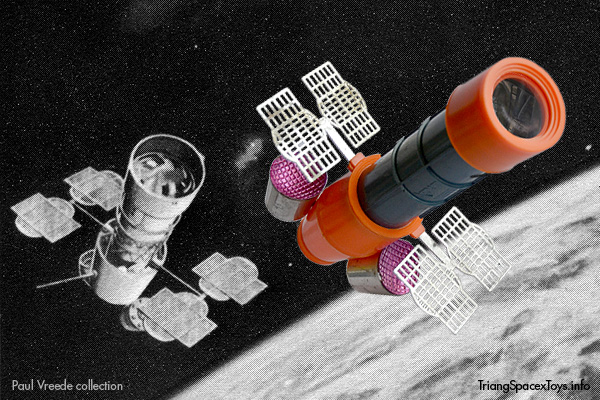
The ATS design was first found in an artist's concept rendering of a telescopic satellite orbiting close by a space station. Bill Bulloch had shown me this image, which he had in a childhood book, but this didn't have any clear explanation of what it was. But then I had a visit from my good friend Robert Yowell, who collects Major Matt Mason and space memorabilia. Who gave me an old book in Dutch that he'd found in Brussels (near where I live). And in that was the exact same picture, but showing enough of the NASA number to have it identified.
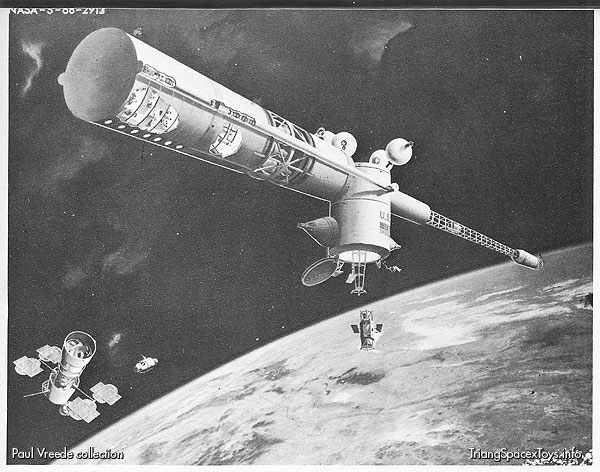
As it happens, Robert used to work at NASA, and was kind enough to ask a former colleague at NASA Archives. Who got us the official caption from 1968:
"MANNED SPACE STATIONS --- Artist’s rendering showing details of an advanced space station concept having a spinning radius of 240 feet at the crew quarters (left end) to provide an artificial gravity field in earth orbit. The station, weighing a total of about one million pounds, would be launched in three segments by three Saturn V launch vehicles and assembled in space. About 50,000 cubic feet of living space and 45,000 cubic feet of laboratory space would be provided by the station. The drawing shows a 120-inch telescope drifting nearby (lower left), a logistics vehicle approaching rendezvous with the station (immediately to right and behind telescope), and a small satellite is being drawn up into the station’s maintenance hangar."
Robert's friend also asked NASA's lead scientist, Steve Hawley - an astronaut who flew the Shuttle five times, including the mission that deployed the Hubble Space Telescope (HST). Who replied (right in the middle of monitoring another Shuttle mission):
"My guess it's an early rendering of HST. In 1968 HST was not a formal NASA start (I think that happened in the early 70's) but it was certainly being debated in the science and space community as a high priority. It was originally proposed in the '40s by Dr. Lyman Spitzer (a famous astronomer) who, as I recall, was a NASA VIP guest for the launch back in 1990. Anyway, back in the '60s it was called LST for Large Space Telescope. It was initially a 3-m telescope (HST ended up being 1.4m) and was, back in those days, envisioned to be serviced by an orbiting space station. My guess is that this rendering intended to capture the various activities that would/could be done from an orbiting space station, including servicing the LST".
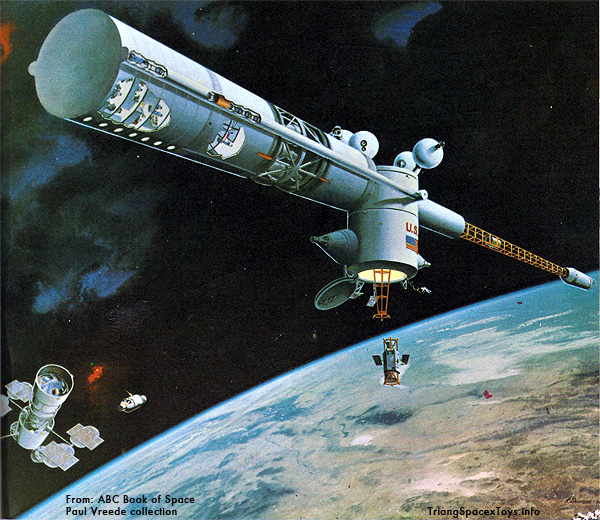
The information from these authoritative sources was published on the Moonbase Central blog at the time, and there matters stayed until I got round to preparing this page, and digging further.
One thing I found was why this image was so popular: it was used for a number of presentations by Dr Robert Gilruth, NASA Director of the Manned Spacecraft Center (now the Johnson Space Center) in 1968. Given the year in the NASA reference number, the painting may possibly have been specifically created for this purpose. At the IV International Symposium on Bioastronautics and the Exploration of Space his presentation was picked up by the Associated Press, with the space station image reaching a number of newspapers (1). The painting is signed at lower right by NASA artist Raymond Bruneau.
The image also turned up in issue #220 of TV21 magazine, published 5 April 1969 with a text describing activities aboard the 'orbiting workshop'.
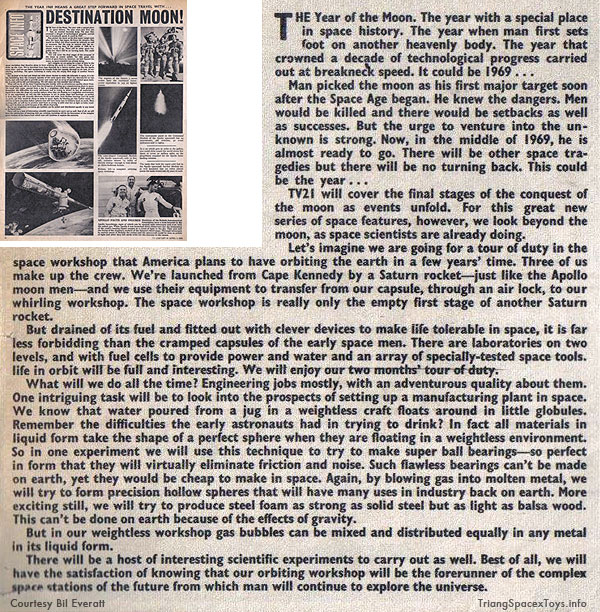
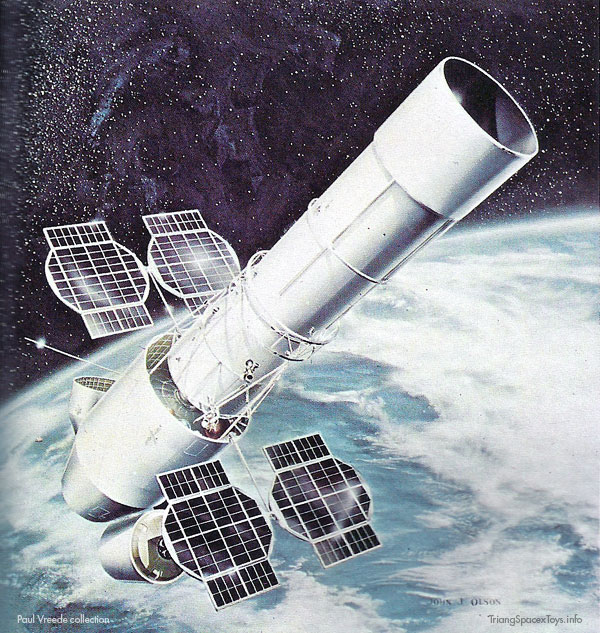
Various searches revealed other contemporary illustrations of the mysterious space telescope, but none that provided clues as to its origin. The one above I came across frequently, and, much later, would find it again in the Encyclopedia of Space (by advisory editor Maurice Allward, published 1968). It is signed John F Olson.
Bill Bulloch also came up with a nice example (below, clearly based on Olson's painting above) from the 1970 Tell Me Why Annual, signed Robinson, although not all the callout captions turned out to be completely correct (click for a readable view in a new window).
And then I found that this same illustration was first published in Ranger magazine in the UK, on 4 April 1966. So there's a chance that this illustration may have been used to design the toy. The 1970 annual appeared too late (the toy being in production by then), but the earlier magazine appearance makes this a distinct possibility.
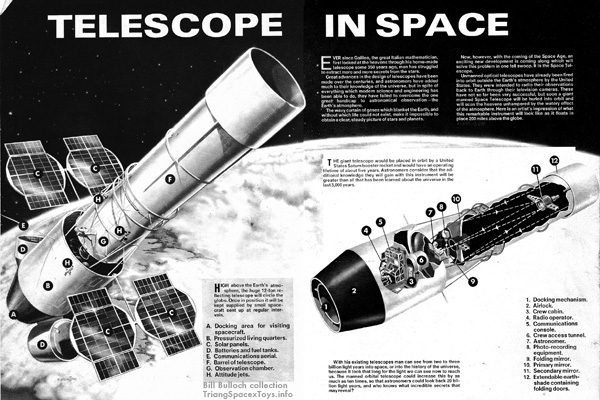
The confusing thing was that most references to early large space telescopes tie it in to the Manned Orbital Research Laboratory (MORL) project, which I initially confused with the large space station seen in the illustration we started with. And tantalisingly, both Astronautix.com and Wikipedia mention a couple of reports on Manned Orbital Telescopes that had meanwhile disappeared from the NASA Technical Reports Server after that had been reorganised. Finding no other sources for these reports, I asked the NASA STI Information Desk for help, and to my glad relief, was notified a few weeks later that one of the reports had been reviewed and was available again. (Thank you again, Ms Dash! :)
And that report, A System Study of a Manned Orbital Telescope, was paydirt! On the cover it has the Boeing name in big Black Italics, confirming vague references I'd found that this company designed this 120-inch telescope. Inside was a (by now) very familiar illustration, in fact the one by Olson (shown above), which must've been commissioned by Boeing. And the 405 pages go into great detail of every aspect concerning this project.(2)
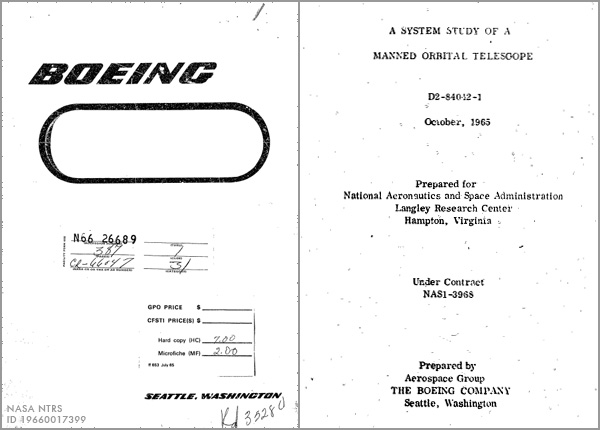
The report also cleared up the mystery about the relationship with the MORL space station. MORL had been intended to be fairly small, and it turns out the telescope is literally tied to it. The rear of the body as seen in the illustrations (and indeed the rear of the Spacex toy) actually -is- the MORL.
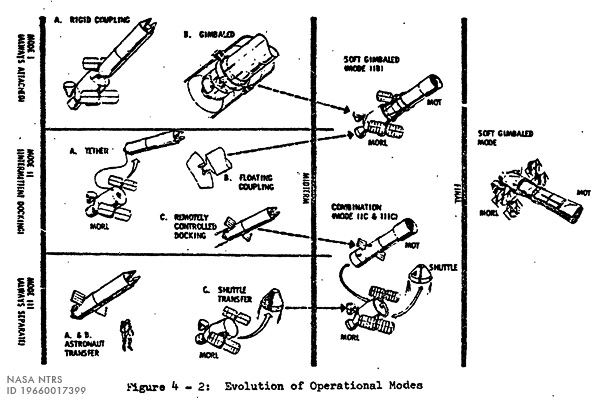
Early considerations (left) included the telescope (MOT) fixed to MORL or with a gimbal arrangement; tethered, or floating apart requiring astronauts to transfer between the two, in a shuttle as an option. Eventually the best aspects of these options were combined into a single configuration, with the MOT sitting on gimbals attached to MORL (right).
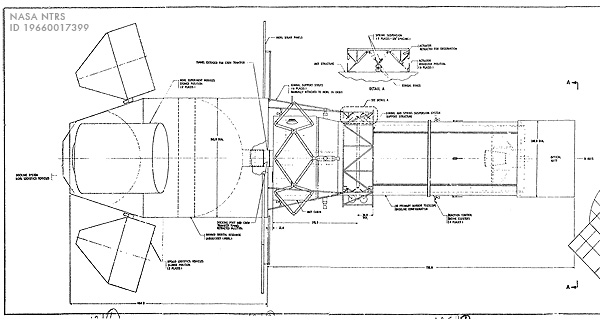
A fold-out drawing shows the MORL-MOT combination in full from side and front (shown here
in two parts). The cylinders at left and right in the front view (and 'in front' on the side view) are indicated as being experiment modules, while the pointed shapes above and below actually represent Apollo logistics vehicles. The detail at top centre shows a gimbal fitting between
MORL and MOT.
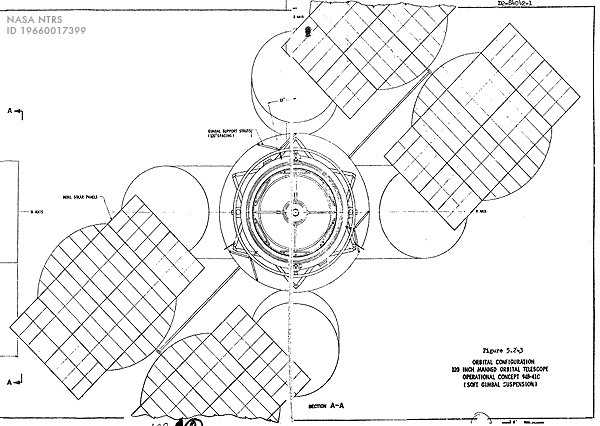
In the course of time, the MORL concept (3) never came to be, with NASA instead launching the more ambitious Skylab in 1973. The MOT/LST telescope eventually became the Hubble Space Telescope which we now know so well, and which since its launch in 1990 continues to amaze with its glorious images of the Universe. (4)
External sites open in new windows.
1: An example of a newspaper story on Gilruth's presentation is included in an article by Yu Zubakin, which has more details about the space station, and both station and telescope appearing on postage stamps. Original in Russian, but readable enough in translation. On his Spaceflight History site, David Portree has an extensive piece on Gilruth and his space stations. back to text
2: The Boeing report can be retrieved from NASA NTRS as a hefty pdf. back to text
3: Mark Wade of course has detailed information and pictures of the MORL project on his outstanding Astronautix encyclopedia. back to text
4: Wikipedia has a good entry and further links on Skylab, as well as on the Hubble Space Telescope. NASA maintains a dedicated webpage on the HST, while the Hubble Heritage site keeps an online gallery of historic Hubble images. back to text